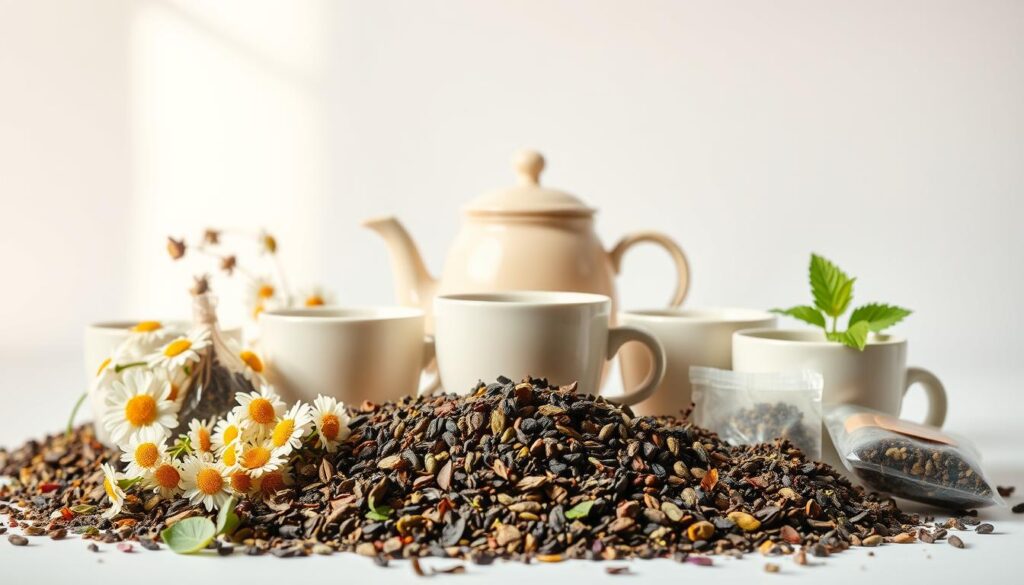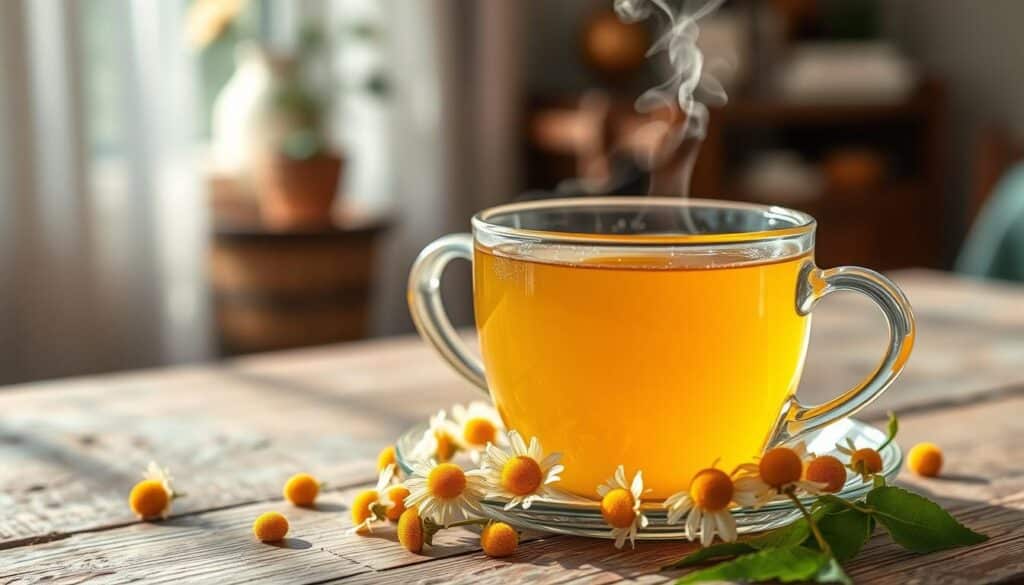Anúncios
Choose Headache-Relieving Foods for quick relief
Headaches are a common affliction that can disrupt daily life. Herbal teas have been gaining popularity as a natural remedy for headache relief.
With the growing interest in natural remedies, many are turning to these soothing beverages to alleviate headache symptoms. Herbal teas offer a gentle, non-invasive approach to managing headaches.
Key Takeaways
- Herbal teas can provide relief from headache symptoms.
- Natural remedies are gaining popularity for headache management.
- Herbal teas offer a non-invasive approach to alleviating headaches.
- Certain herbal teas have properties that can help soothe headache pain.
- Incorporating herbal teas into your daily routine can be beneficial.

Natural Foods to Relieve Headaches
Understanding Headaches and Their Natural Solutions
Understanding headaches is crucial for finding effective relief, and natural solutions are increasingly becoming the preferred choice for many sufferers. Headaches are a widespread health issue that can significantly impact daily life.
Common Types of Headaches and Their Causes
Headaches are generally categorized into primary and secondary types. Primary headaches, such as tension headaches and migraines, are not symptoms of underlying medical conditions. Tension headaches are often caused by stress, poor posture, or muscle strain, while migraines can be triggered by hormonal changes, certain foods, or sensory stimuli.
Why Natural Remedies Are Gaining Popularity
Natural remedies are becoming more popular due to their potential for relief with fewer side effects compared to some conventional medications. Many people are seeking holistic approaches to manage their headache symptoms.
The Role of Hydration in Headache Prevention
Hydration plays a crucial role in headache prevention. Dehydration is a common trigger for headaches, making it essential to drink enough water throughout the day. The relationship between hydration and headache prevention is supported by research, highlighting the importance of adequate fluid intake.
| Hydration Level | Headache Frequency | Headache Severity |
|---|---|---|
| Adequate | Low | Mild |
| Inadequate | High | Severe |
By understanding the causes of headaches and incorporating natural remedies, such as proper hydration, individuals can better manage their symptoms and improve their quality of life.
How Herbal Teas Work to Alleviate Headache Pain
Understanding how herbal teas work to alleviate headache pain requires a look into their anti-inflammatory, relaxing, and circulatory benefits. Herbal teas have been a cornerstone of natural remedy practices for centuries, offering a holistic approach to managing headache pain.
Anti-inflammatory Properties of Herbal Compounds
Many herbal teas are rich in anti-inflammatory compounds that help reduce the inflammation that can cause or exacerbate headache pain. For instance, teas containing ginger or turmeric have been shown to have potent anti-inflammatory effects.
| Herbal Tea | Anti-inflammatory Compound |
|---|---|
| Ginger Tea | Gingerol |
| Turmeric Tea | Curcumin |
Muscle Relaxation and Tension Relief
Herbal teas like chamomile and lavender are known for their muscle relaxation properties, helping to alleviate the tension that often leads to headaches. Relaxation is key to preventing tension headaches.
“The calming effects of herbal teas can significantly reduce stress and tension, providing relief from headache pain.”
Stress Reduction and Mood Enhancement
Stress is a common headache trigger. Herbal teas such as peppermint and lemon balm can help reduce stress and enhance mood, thereby reducing the likelihood of stress-induced headaches.
Improved Circulation and Oxygen Flow
Some herbal teas are believed to improve circulation, which can help alleviate headache pain by ensuring that the brain receives adequate oxygen and nutrients.
By understanding the mechanisms through which herbal teas work, individuals can make informed choices about their headache management strategies.
Natural Teas for Headache: Science-Backed Options

For centuries, various cultures have turned to natural teas to alleviate headache pain, and recent scientific research has begun to validate these traditional remedies. This blend of historical use and modern science provides a comprehensive understanding of how natural teas can be used to manage headaches.
Historical Use Across Different Cultures
The use of herbal teas for medicinal purposes dates back thousands of years, with various cultures employing them to treat a range of ailments, including headaches. In ancient China, for example, herbal teas were used not only for their flavor but also for their perceived health benefits. Similarly, in Europe, traditional herbal medicine often featured teas made from local flora to treat headache and other conditions.
“The use of herbal remedies for headache relief is deeply rooted in traditional medicine across the globe, reflecting a universal recognition of their potential benefits.”
Recent Scientific Research and Findings
Recent studies have begun to scientifically validate the historical use of certain herbal teas for headache relief. For instance, research on feverfew tea has shown its potential in reducing migraine frequency and severity. Similarly, studies on ginger tea have highlighted its anti-inflammatory properties, which may contribute to its effectiveness in alleviating headache pain.
| Herbal Tea | Key Benefit | Scientific Evidence |
|---|---|---|
| Feverfew | Reduces migraine frequency | Multiple clinical trials |
| Ginger | Anti-inflammatory effects | In vitro and in vivo studies |
| Peppermint | Relaxes muscles, improves circulation | Human trials and traditional use |
Comparing Effectiveness with Conventional Treatments
When comparing natural teas to conventional headache treatments, several factors come into play. While conventional medications can offer quick relief, they often come with side effects and the risk of dependency. Natural teas, on the other hand, provide a generally safer alternative, with fewer side effects, although their effectiveness can vary from person to person.
In conclusion, natural teas offer a promising avenue for headache relief, backed by both historical use and emerging scientific evidence. As research continues to uncover the benefits and mechanisms behind these teas, they are likely to become an increasingly important part of headache management strategies.
Peppermint Tea: The Cooling Relief for Tension Headaches
The cooling properties of peppermint tea make it an ideal choice for alleviating tension headaches. This refreshing beverage has been used for centuries to soothe various ailments, and its effectiveness in relieving headache pain is backed by science.
How Menthol Affects Pain Receptors
Peppermint tea contains menthol, a compound that interacts with pain receptors in the body. Menthol activates the TRPM8 receptors, which are responsible for detecting cold temperatures, thereby producing a cooling sensation that can help alleviate pain.
Menthol’s analgesic properties make peppermint tea an effective natural remedy for tension headaches. By reducing pain perception, menthol helps to ease the discomfort associated with headaches.
Perfect Brewing Methods for Maximum Benefits
To maximize the benefits of peppermint tea, it’s essential to brew it correctly. Steep fresh or dried peppermint leaves in boiling water for 5-7 minutes. The ideal ratio is about 1 tablespoon of leaves per cup of water.
Using high-quality peppermint leaves ensures that your tea is rich in menthol and other beneficial compounds. You can adjust the steeping time to suit your taste preferences.
Recommended Dosage and Timing
For optimal relief, it’s recommended to drink peppermint tea at the onset of headache symptoms. Consuming 2-3 cups throughout the day can help maintain its therapeutic effects.
Fresh vs. Dried Peppermint Leaves
Both fresh and dried peppermint leaves can be used to make effective tea. Fresh leaves provide a more vibrant flavor and aroma, while dried leaves offer a more concentrated menthol content. Choose based on your personal preference and availability.
Ultimately, the choice between fresh and dried leaves depends on your individual needs and the desired intensity of the tea.
Ginger Tea: A Powerful Ally Against Migraines
The active compounds in ginger tea make it a powerful ally in the fight against migraines. Ginger has been used for centuries in various cultures for its medicinal properties, particularly its ability to reduce inflammation and alleviate nausea.
Anti-inflammatory and Anti-nausea Effects
Ginger contains gingerols and shogaols, compounds that have potent anti-inflammatory properties. These compounds can help reduce the inflammation that often accompanies migraines. Additionally, ginger’s anti-nausea effects can provide relief from the nausea and vomiting that frequently occur during migraine episodes.
Creating the Perfect Ginger Tea Infusion
To make ginger tea, start by peeling and slicing fresh ginger. Use about 1-2 teaspoons of ginger for every cup of boiling water. Steep the ginger in the water for 5-10 minutes, depending on your desired strength of flavor. You can strain the tea before serving or leave the ginger slices in for added potency.
Combining Ginger with Honey and Lemon
Enhance your ginger tea by adding honey and lemon. Honey can help soothe the throat, while lemon adds a burst of citrus flavor and additional anti-inflammatory properties. Mix in 1 teaspoon of honey and a squeeze of fresh lemon juice into your ginger tea for a delicious and therapeutic drink.
Using Fresh vs. Powdered Ginger
Both fresh and powdered ginger can be effective for making ginger tea. Fresh ginger provides a more vibrant flavor and potentially more medicinal properties, while powdered ginger is convenient and still retains many of its beneficial compounds. For a quick option, use 1/4 teaspoon of powdered ginger per cup of boiling water.
Incorporating ginger tea into your routine can be a simple yet effective way to manage migraines. With its anti-inflammatory and anti-nausea effects, ginger tea is a natural remedy worth trying.
Calming Herbal Infusions: Chamomile, Lavender, and Valerian

For those seeking relief from stress-induced headaches, calming herbal infusions such as chamomile tea, lavender tea, and valerian root offer a natural solution. These herbal remedies have been used for centuries to promote relaxation and reduce stress, which can contribute to headache prevention.
Sedative and Relaxing Properties of Chamomile
Chamomile tea is renowned for its sedative and relaxing properties. The apigenin in chamomile binds to certain receptors in the brain, potentially reducing anxiety and promoting relaxation. This can be particularly beneficial for individuals whose headaches are triggered or exacerbated by stress.
Lavender Tea for Stress-Induced Headaches
Lavender tea is another calming infusion that can help alleviate stress-induced headaches. The aroma of lavender alone has been shown to reduce anxiety and promote relaxation. When consumed as a tea, lavender’s effects can be even more pronounced, helping to calm the nervous system and reduce headache symptoms.
Valerian Root: The Natural Sleep Aid for Headache Prevention
Valerian root is well-known for its ability to improve sleep quality. Since poor sleep is a common headache trigger, using valerian root as a natural sleep aid can be an effective strategy for headache prevention. By promoting a restful night’s sleep, valerian root can help reduce the frequency and severity of headaches.
Creating Custom Blends for Enhanced Effects
One of the benefits of herbal teas is the ability to create custom blends tailored to individual needs. For example, combining chamomile tea with lavender tea can enhance relaxation and promote a restful night’s sleep. Adding a touch of valerian root to this blend can further improve its sleep-promoting properties.
| Herbal Infusion | Primary Benefit | Headache Relief Potential |
|---|---|---|
| Chamomile Tea | Relaxation and Sedation | High |
| Lavender Tea | Stress Reduction | Moderate to High |
| Valerian Root | Improved Sleep Quality | High |
By understanding the unique benefits of each herbal infusion, individuals can create personalized blends to enhance their headache relief strategy. Whether it’s chamomile tea for relaxation, lavender tea for stress reduction, or valerian root for improved sleep, these natural remedies offer a holistic approach to managing headaches.
Caffeinated Options: Green, Black, and White Teas
Among the various teas available, green, black, and white teas stand out for their caffeine content and potential impact on headache symptoms. These teas have been consumed for centuries, not only for their flavor but also for their medicinal properties.
The Dual Nature of Caffeine in Headache Treatment
Caffeine’s role in headache treatment is complex. On one hand, it can constrict blood vessels and block pain pathways in the brain, providing relief. On the other hand, excessive caffeine consumption or withdrawal from it can trigger or worsen headaches.
Caffeine’s Effects:
- Constricts blood vessels
- Blocks pain pathways
- Can trigger or worsen headaches if consumed excessively or withdrawn from
Green Tea’s Antioxidants and Pain-Relieving Properties
Green tea is rich in antioxidants, which help reduce inflammation and potentially alleviate headache pain. Its moderate caffeine content can also contribute to headache relief by improving blood flow.
Black Tea’s Traditional Use for Headache Relief
Black tea has been traditionally used to treat headaches due to its caffeine content and theaflavins, which are believed to have anti-inflammatory properties.
| Tea Type | Caffeine Content | Potential Benefits |
|---|---|---|
| Green Tea | Moderate | Antioxidants, improved blood flow |
| Black Tea | Higher | Theaflavins, anti-inflammatory effects |
| White Tea | Low | Gentle caffeine boost, minimal processing |
White Tea: The Gentle Alternative
White tea, with its minimal processing and low caffeine content, offers a gentle alternative for those sensitive to caffeine. Its subtle flavor and potential health benefits make it an attractive option for headache sufferers.
“The subtlety of white tea, with its minimal processing, makes it an excellent choice for those looking for a gentle, caffeinated beverage option.”
In conclusion, caffeinated teas like green, black, and white tea can play a significant role in headache management. Understanding their unique properties and caffeine content can help individuals make informed choices about their use.
Lesser-Known Teas with Headache-Fighting Properties
In the realm of natural remedies, certain lesser-known teas have emerged as potent allies in the fight against headaches. These teas, while not as widely recognized as some of their more popular counterparts, offer unique benefits that can provide significant relief.
Feverfew Tea: The Migraine Specialist
Feverfew tea has been traditionally used to treat migraines and other headaches. Its active compounds are believed to reduce inflammation and prevent the blood vessels from dilating, which can be a significant factor in migraine relief.
Willow Bark: Nature’s Aspirin
Willow bark contains salicin, a compound similar to aspirin. It has been used for centuries to alleviate pain and reduce inflammation, making it an effective natural remedy for headache sufferers.
Butterbur and Its Preventative Effects
Butterbur has been shown in some studies to be effective in preventing migraines. Its mechanism is not fully understood, but it’s believed to reduce inflammation and improve blood flow.
Linden Flower Tea for Vascular Headaches
Linden flower tea is known for its calming effects and is often used to treat vascular headaches. It can help to relax the blood vessels and improve circulation, potentially reducing headache severity.
| Tea | Primary Benefit | Headache Type |
|---|---|---|
| Feverfew Tea | Migraine Prevention | Migraines |
| Willow Bark | Pain Relief | Tension, Migraines |
| Butterbur | Migraine Prevention | Migraines |
| Linden Flower Tea | Vascular Relaxation | Vascular Headaches |
These lesser-known teas offer a range of benefits for headache sufferers, from pain relief to prevention. By incorporating them into their routine, individuals may find significant relief from headache symptoms.
Conclusion: Creating Your Personal Headache Relief Tea Strategy
Now that we’ve explored the various teas that can help alleviate headache pain, it’s time to create a personalized tea plan tailored to your specific needs. Experimenting with different teas and blends can help you discover what works best for you.
Consider your headache type, whether it’s a tension headache or migraine, and choose teas that cater to your condition. For instance, peppermint tea can be ideal for tension headaches, while ginger tea may be more effective for migraines. You can also combine different teas to create a unique blend that suits your taste preferences.
Developing a headache relief strategy involves trial and error, as well as patience. Start by trying out individual teas, then adjust your approach as needed. Keep track of your progress, and don’t hesitate to explore new options until you find the perfect blend that brings you relief.
FAQ
What are the most effective teas for headache relief?
How does peppermint tea help with tension headaches?
Can ginger tea help with migraines?
Are caffeinated teas like green, black, and white tea effective for headache relief?
How can I create a custom tea blend for headache relief?
Are there any teas that can help prevent headaches?
Can I use dried or powdered herbs instead of fresh ones for tea?
How often should I drink tea for headache relief?
Content created with the help of Artificial Intelligence.



